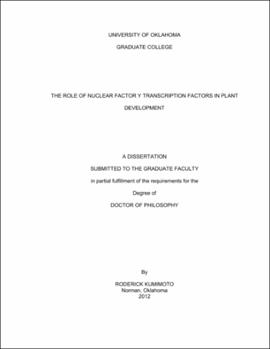| dc.description.abstract | Due to their sessile nature, plants must coordinate their growth and development based on the surrounding environmental conditions. This coordination is regulated by alterations in gene expression, leading to appropriate developmental outcomes. Transcription factors are instrumental in integrating environmental signals by modulating gene activity at the mRNA level. NUCLEAR FACTOR Y (NF-Y) is a hetrotrimeric transcription factor comprised of the subunits NF-YA, NF-YB and NF-YC. Although NF-Y are well studied in animal and fungal systems, little is know about their function in plants. Despite the paucity of genetically defined roles for NF-Y in plants, NF-Y has been implicated in a number of critical developmental processes. Here I describe the overlapping and opposing functionality of multiple NF-Y genes in three developmental processes using reverse genetic approaches in Arabidopsis thaliana. In chapter two, candidate NF-YC genes regulating photoperiodic flowering were defined by assaying tissue specific expression patterns. Creating a triple mutant of NF-YC3, NF-YC4 and NF-YC9 revealed their overlapping functionality in stimulating flowering in response to inductive photoperiods. Further, NF-YC3, C4 and C9 were shown to physically interact with transcription factor CONSTANS, a well-known regulator of photoperiodic flowering. In addition, NF-Y are required for CONSTANS to activate its down stream target FLOWERING LOCUS T. To determine NF-YC functions outside of flowering time, microarrays were performed on NF-YC3, C4, C9 triple mutant plants. Analysis of the microarray data led to the hypothesis that NF-Y play a role in abscisic acid (ABA) signaling. Chapter three investigates this hypothesis. Phenotypic analysis of mutant combinations of NF-YC3, C4 and C9 demonstrate a clear role for these genes in determining germination timing in response to ABA. Unlike in flowering where NF-YC3, C4 and C9 have overlapping functionality, NF-YC3 and NF-YC9 have opposing role to NF-YC4 in response to ABA. In addition, yeast two hybrid screens showed that NF-YC can interact with bZIP transcription factor involved in ABA responses. Yeast two hybrid screens demonstrate that NF-Y not only interacts with CONSTANS but with many members of the CONSTANS-Like gene family. This led to the hypothesis that interactions between NF-Y and the CONSTANS-Like gene family are common, yet previous functional associations between these gene families were limited to the flowering time phenotype. One such example is my finding that CONSTANS-Like 3 physically interacts with NF-YC subunits. CONSTANS-Like 3 has a demonstrated role in photomorphogenesis, suggesting that NF-YC proteins may also have a role in this process. In chapter four, NF-Y subunits are shown to also play a role in photomorphogenesis similar to that of CONSTANS-Like 3. These data imply that the NFY/ CONSTANS-Like association extends beyond flowering and are likely to be widespread. | |
